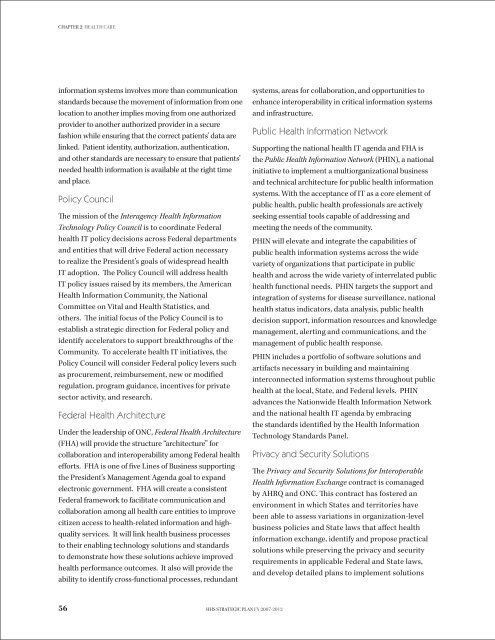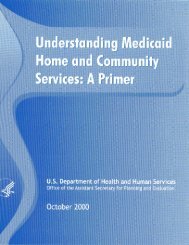STRATEGIC PLAN - ASPE - U.S. Department of Health and Human ...
STRATEGIC PLAN - ASPE - U.S. Department of Health and Human ...
STRATEGIC PLAN - ASPE - U.S. Department of Health and Human ...
Create successful ePaper yourself
Turn your PDF publications into a flip-book with our unique Google optimized e-Paper software.
CHAPTER 2: <strong>Health</strong> careinformation systems involves more than communicationst<strong>and</strong>ards because the movement <strong>of</strong> information from onelocation to another implies moving from one authorizedprovider to another authorized provider in a securefashion while ensuring that the correct patients’ data arelinked. Patient identity, authorization, authentication,<strong>and</strong> other st<strong>and</strong>ards are necessary to ensure that patients’needed health information is available at the right time<strong>and</strong> place.Policy CouncilThe mission <strong>of</strong> the Interagency <strong>Health</strong> InformationTechnology Policy Council is to coordinate Federalhealth IT policy decisions across Federal departments<strong>and</strong> entities that will drive Federal action necessaryto realize the President’s goals <strong>of</strong> widespread healthIT adoption. The Policy Council will address healthIT policy issues raised by its members, the American<strong>Health</strong> Information Community, the NationalCommittee on Vital <strong>and</strong> <strong>Health</strong> Statistics, <strong>and</strong>others. The initial focus <strong>of</strong> the Policy Council is toestablish a strategic direction for Federal policy <strong>and</strong>identify accelerators to support breakthroughs <strong>of</strong> theCommunity. To accelerate health IT initiatives, thePolicy Council will consider Federal policy levers suchas procurement, reimbursement, new or modifiedregulation, program guidance, incentives for privatesector activity, <strong>and</strong> research.Federal <strong>Health</strong> ArchitectureUnder the leadership <strong>of</strong> ONC, Federal <strong>Health</strong> Architecture(FHA) will provide the structure “architecture” forcollaboration <strong>and</strong> interoperability among Federal healthefforts. FHA is one <strong>of</strong> five Lines <strong>of</strong> Business supportingthe President’s Management Agenda goal to exp<strong>and</strong>electronic government. FHA will create a consistentFederal framework to facilitate communication <strong>and</strong>collaboration among all health care entities to improvecitizen access to health-related information <strong>and</strong> highqualityservices. It will link health business processesto their enabling technology solutions <strong>and</strong> st<strong>and</strong>ardsto demonstrate how these solutions achieve improvedhealth performance outcomes. It also will provide theability to identify cross-functional processes, redundantsystems, areas for collaboration, <strong>and</strong> opportunities toenhance interoperability in critical information systems<strong>and</strong> infrastructure.Public <strong>Health</strong> Information NetworkSupporting the national health IT agenda <strong>and</strong> FHA isthe Public <strong>Health</strong> Information Network (PHIN), a nationalinitiative to implement a multiorganizational business<strong>and</strong> technical architecture for public health informationsystems. With the acceptance <strong>of</strong> IT as a core element <strong>of</strong>public health, public health pr<strong>of</strong>essionals are activelyseeking essential tools capable <strong>of</strong> addressing <strong>and</strong>meeting the needs <strong>of</strong> the community.PHIN will elevate <strong>and</strong> integrate the capabilities <strong>of</strong>public health information systems across the widevariety <strong>of</strong> organizations that participate in publichealth <strong>and</strong> across the wide variety <strong>of</strong> interrelated publichealth functional needs. PHIN targets the support <strong>and</strong>integration <strong>of</strong> systems for disease surveillance, nationalhealth status indicators, data analysis, public healthdecision support, information resources <strong>and</strong> knowledgemanagement, alerting <strong>and</strong> communications, <strong>and</strong> themanagement <strong>of</strong> public health response.PHIN includes a portfolio <strong>of</strong> s<strong>of</strong>tware solutions <strong>and</strong>artifacts necessary in building <strong>and</strong> maintaininginterconnected information systems throughout publichealth at the local, State, <strong>and</strong> Federal levels. PHINadvances the Nationwide <strong>Health</strong> Information Network<strong>and</strong> the national health IT agenda by embracingthe st<strong>and</strong>ards identified by the <strong>Health</strong> InformationTechnology St<strong>and</strong>ards Panel.Privacy <strong>and</strong> Security SolutionsThe Privacy <strong>and</strong> Security Solutions for Interoperable<strong>Health</strong> Information Exchange contract is comanagedby AHRQ <strong>and</strong> ONC. This contract has fostered anenvironment in which States <strong>and</strong> territories havebeen able to assess variations in organization-levelbusiness policies <strong>and</strong> State laws that affect healthinformation exchange, identify <strong>and</strong> propose practicalsolutions while preserving the privacy <strong>and</strong> securityrequirements in applicable Federal <strong>and</strong> State laws,<strong>and</strong> develop detailed plans to implement solutions56 HHS Strategic Plan FY 2007-2012
















